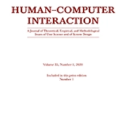We present a method to simulate movement in interaction with computers, using Model Predictive Control (MPC). The method starts from understanding interaction from an Optimal Feedback Control (OFC) perspective. We assume that users aim to minimize an internalized cost function, subject to the constraints imposed by the human body and the interactive system. In contrast to previous linear approaches used in HCI, MPC can compute optimal controls for nonlinear systems. This allows us to use state-of-the-art biomechanical models and handle nonlinearities that occur in almost any interactive system. Instead of torque actuation, our model employs second-order muscles acting directly at the joints. We compare three different cost functions and evaluate the simulated trajectories against user movements in a Fitts' Law type pointing study with four different interaction techniques. Our results show that the combination of distance, control, and joint acceleration cost matches individual users' movements best, and predicts movements with an accuracy that is within the between-user variance. To aid HCI researchers and designers, we introduce CFAT, a novel method to identify maximum voluntary torques in joint-actuated models based on experimental data, and give practical advice on how to simulate human movement for different users, interaction techniques, and tasks.
翻译:我们用模型预测控制(MPC)来模拟与计算机互动的移动。该方法始于从最佳反馈控制(OFC)的角度来理解互动。我们假设用户的目标是尽量减少内部成本功能,但受人体和互动系统的限制。与HCI以往使用的线性方法相比,MPC可以计算非线性系统的最佳控制方法。这使我们能够使用最先进的生物机械模型,处理几乎任何互动系统中发生的非线性变化。我们的模式使用的是二阶肌肉,而不是扭动作用,而是直接在联合体中操作。我们比较了三种不同的成本功能,并用四种不同的互动技术评估模拟轨道,以对抗Fitts法律类型中的用户移动。我们的结果显示,距离、控制和联合加速成本的组合与用户的移动最佳匹配,并预测几乎在用户间差异范围内发生的非线性变化。为了帮助 HCI 研究人员和设计者,我们采用了一种新型的方法,用以在联合活动模型和不同模拟模型中,为不同用户提供最大自愿的实验性任务。





